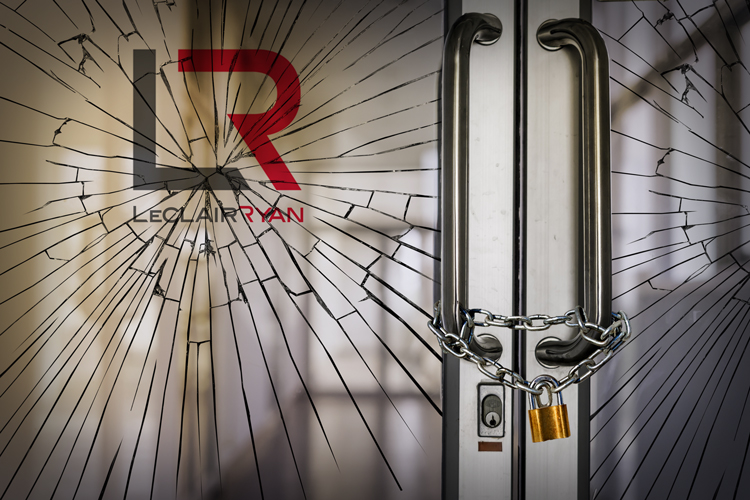Too big too soon: How LeClairRyan went under

Photo illustration by Brenan Sharp.
House calls are usually something associated with doctors, not lawyers. Yet on Jan. 1, 2006, Gary LeClair, the founding partner of the firm that bore his name, rang in the new year by heading over to one of his partners’ houses with a special deal in mind.
John Fitzpatrick, then a litigation shareholder at LeClairRyan, had joined the Richmond, Virginia, firm in 1996—and at first, he had been gloriously happy. “What [LeClairRyan] offered seemed like a breath of fresh air,” he remembers. “It was a true meritocracy: If you brought in business—if you worked and generated business—you would be compensated.”
“Those first five years at LeClairRyan were fabulous,” he says. “I thought I was at the firm I’d never leave.”
However, Fitzpatrick had become disillusioned. According to him, by the turn of the century, the new objective was to run the firm like a corporation. C-suite bureaucracy was introduced, and the meritocratic structure that Fitzpatrick valued began to crumble.
But standing on that front step, LeClair didn’t want Fitzpatrick to leave. So he brought a tried-and-true corporate strategy: the carrot-and-stick. According to Fitzpatrick, if he stayed, the reforms he wanted would be instituted, and he’d receive a $650,000 bonus check and a special $1 million retirement plan if he stayed another four years. If he left, LeClair told him, he’d fire the 20 people who worked for him, including Fitzpatrick’s own brother, James. LeClair did not respond to a request for comment.
Fitzpatrick accepted that New Year’s Day offer, but he says that after a year, the changes he had been promised had not come to pass—except that $650,000 bonus check. So he quit and headed west to Denver to join Wheeler Trigg O’Donnell to continue his legal career.
“It was a fabulous firm when we started,” Fitzpatrick says, “and it became a different firm.”
This different firm spent the 13 years after Fitzpatrick’s exit aggressively growing—joining the Am Law 200—while being unable to make ends meet.
In July, the firm voted to go into bankruptcy. The previous month, Gary LeClair packed his bags and headed for Williams Mullen, where he is currently a partner based in the firm’s Richmond office. In her declaration in support of the firm’s 2019 bankruptcy petition, Lori Thompson, a former LeClairRyan shareholder and chair of the dissolution committee, wrote: “After growing into a large national law firm, LeClairRyan experienced declines in gross revenue and profitability in recent years. Those declines led to the departure of numerous attorneys, and those departures accelerated in 2019 … Despite best efforts, LeClairRyan could not stop the wave of attorney departures.”
While there was no single point of failure, undisciplined acquisitions, ad hoc and expensive compensation schemes like Fitzpatrick’s, and financial mismanagement coalesced to bring the firm’s ruin, several former shareholders say. LeClairRyan’s demise—one of several firm failures in the last decade—is as much a story about a single firm as it is a warning to others in a softening economy.
Rapid Expansion
Founded in 1988 by two former Hunton & Williams corporate lawyers, Gary LeClair and Dennis Ryan, LeClairRyan started as a regional business firm in Virginia. The firm initially focused on venture capital clients and got by on credit card advances, according to Forbes.
“It was a great, exciting environment—there was a lot of energy,” says one former shareholder who was at the firm at the turn of the century. This shareholder, along with others, spoke to the Journal on condition of anonymity due to the ongoing bankruptcy litigation and a desire to preserve relations among current and former colleagues at LeClairRyan. “There was very much a sense that this is a dynamic organization that is not stagnant—or going the opposite direction—it’s growing.”
However, the market was uninterested in a firm that only handled venture capital work. So the firm focused on the needs of growing regional business clients that shareholder remembers.
Throughout the 1990s, the firm grew slowly and was seen as a solid regional player. Then the dot-com bust came at the turn of the century, and things began to change.

John Fitzpatrick. Photo courtesy of Wheeler Trigg O’Donnell.
As Fitzpatrick recalls, LeClair began to shift strategy and wanted to run the firm like a corporation where he would be CEO.
Thus began Fitzpatrick’s disillusionment with the firm. The new corporatelike structure was top-heavy, expensive and populated with people not billing enough to justify their salaries. It also led to a lot of proposals.
“We had more five-year plans than the Russians did,” none of which were being implemented, Fitzpatrick says.
One plan that the firm had decided to implement was one of rapid growth—primarily through acquisitions of firms and practice groups around the country. Beginning in 2006, the firm opened offices or acquired firms in New York City; Boston; Newark, New Jersey; Los Angeles; San Francisco; Houston; Chicago; and New Haven and Hartford, Connecticut. At the time of its dissolution, the firm had 21 offices in the U.S.
Some of the moves raised eyebrows—both within and outside the firm. Analysts were taking note as people started leaving.
“There were things about them that made me wonder what [LeClairRyan’s] strategy was and what the future would hold for them,” says Kent Zimmermann, a principal at Zeughauser Group in Chicago. “In retrospect, having seen the result, there were some flags earlier on.”
For Zimmermann, he remembers seeing the firm expand into upstate New York and take on more insurance work—and both put downward pressure on billing rates.
During this time of growth, the firm didn’t fully appreciate how big it had become, another shareholder says.
“It still thought and ran itself as if it was a 40-person firm out of Richmond, Virginia,” he adds.
According to shareholders who spoke with ABA Journal, this rapid-growth strategy was a “bet the house” move that bar associations would reform long-standing regulations barring nonlawyers from having ownership stakes in law firms. Australia and the United Kingdom had done away with them and embraced all sorts of alternative business structures, including publicly traded law firms. Anticipating that such reforms would happen in the U.S., the firm positioned itself to be the country’s first publicly traded law firm. Of course, those changes never took place—indeed, they continue to be hotly debated and controversial to this day.
Some shareholders say that there was a moment during this period of growth to slow down, assess and streamline the firm. Instead, the firm’s overhead grew by opening offices in expensive cities while underperforming practice groups and underbilling attorneys were tolerated by management.
The firm’s leaders did make changes, but it was often to the detriment of the bottom line.
In one example, as the firm changed its management structure to have attorneys take on full-time managerial positions, “soft-landing” contracts were provided to guarantee a certain level of compensation when they returned to practice, regardless of their billable work.
“That became an additional burden on the financial strength of the firm, because you had a cadre of individuals who stopped producing but demanded the same level of compensation,” a shareholder says.
‘Raise Culture’
As economic tumult continued to increase behind the scenes, a public employment and gender discrimination lawsuit against the firm turned into a portentous preview of LeClairRyan’s pending collapse.
In January 2016, firm shareholder Michele Burke Craddock filed a discrimination lawsuit in the U.S. District Court for the Eastern District of Virginia alleging LeClairRyan paid male shareholders more than her even though she generated far more billable hours.
“Repeatedly, origination decisions were made in favor of male shareholders and against female shareholders,” Craddock said in her complaint. “This subjective application of origination decisions has systematically been applied so as to favor male shareholders, and disfavor female shareholders, and/or has had such adverse effect on female shareholders.”
Specifically, she pointed to Colgate v. Disthene, a high-profile case in which she and two male shareholders (one of whom became her husband) represented minority shareholders of the Disthene Group Inc., a Virginia company that owns the largest kyanite mine in the world, The three recovered over $20 million in 2013—the biggest fee recovery in LeClairRyan history. According to Craddock, the clients had actually fired the firm at one point only for Craddock to convince them to come back. Despite that, she claims she was not given origination credit, which would have entitled her to a greater share of the attorney fees from the case.
The firm denied Craddock’s claims, stating at the time: “We are proud of the opportunities that women have at the firm, which has been noted by national organizations.” The arbitration panel that eventually heard the case noted that the firm exceeded the national averages for women equity partners and associates and had women in leadership positions. In its court papers, the firm pointed out that Craddock had been promoted to shareholder early and that the firm had entered into an “extraordinary bonus agreement proposed by Ms. Craddock and two male shareholders” on the Colgate matter where they each received a $1,112,796.26 even though Craddock did not have origination credit.
Hidden in the case’s documents was a revelation about the firm’s financial health. According to the arbitration decision, the firm admitted that it had to cut Craddock’s compensation because it couldn’t afford not to. Revealing that it had missed budget for the first time in its history in 2011—and again in 2012, 2013 and 2014—the firm cut many shareholders’ compensation, leading to departures. The decision noted that LeClairRyan “pointed to the untenable results of its automatic ‘raise culture’ years and the need to reconsider its practices.”
The panel ruled in Craddock’s favor and awarded her over $1 million in back pay, attorney fees and compensatory damages. The firm declared bankruptcy before it could pay her the award. In November, a U.S. Bankruptcy Judge Kevin Huennekens of the Eastern District of Virginia ruled Craddock could begin collecting, but that if she could not recover her full amount from sources other than the property of the estate, then she would become a creditor in the firm’s bankruptcy.
“Perhaps our biggest challenge is our lack of capital,” Gary LeClair told Forbes in a 2015 interview. “We continually are navigating our capital constraints. We need to make substantial investments in the legal process optimization steps required to deliver ‘better, faster, cheaper’ legal services.”
To plug some holes, there was a push at the firm for more attorneys to make shareholder, which cost $100,000 to buy in. According to one shareholder, associates were getting promoted to shareholder before their client list was deep enough to generate enough business.
Several shareholders who spoke to the Journal have raised questions about the firm’s approach to raising capital in its final years. One shareholder argues that the soft-landing contracts given to certain shareholders “could potentially be looked at as to whether there was valid consideration and there was appropriate disclosures and whether there was a real benefit that was received in exchange for those sums.” He qualifies his statement by adding that he doesn’t know what the firm said to lenders or other partners.
Another shareholder points out that the firm continued to entice lateral hires up to the end, although it’s unclear what representations were made to those last-aboard recruits.
Zimmermann notes that a dissolved firm leaves a lot of unhappy partners in its wake, leaving some to lash out. However, the American Lawyer found that LeClairRyan’s actual revenue for 2017 and 2018 was millions of dollars less than what it was telling reporters at the time.
Even as new shareholders were being brought on, existing ones were seeing diminishing returns on their investments. When budgets were missed, shareholders saw their compensation get cut. One shareholder claims he received 80% of what was expected, and at one point, he was making about the same money he made as an associate—worse, he still had to make his payments on the loan he took out to pay for his $100,000 capital contribution.
The firm’s precariousness got so bad that some partners were being required to buy preferred stock, guaranteeing an 8% return, which was later reduced to 4%, one shareholder says.
As dissension grew among equity shareholders, in 2018 the firm announced a high-profile deal with UnitedLex, an enterprise legal services provider, as the start of “law firm 2.0.”
Shareholders were being told that this deal was the means to get their equity back, but those terms were dropped by the time the final deal was presented for approval, a shareholder says.
Once signed, about 300 of LeClairRyan’s back-office employees moved to a new partnership called ULX Partners, which would provide services back to LeClairRyan and potentially other firms in the future. Other LeClairRyan employees lost their jobs. UnitedLex did not respond to a request for comment.
The firm never saw the benefits of this deal, as its problems were much larger than moving some employees off of its balance sheet. According to bankruptcy documents, the firm had a 1% ownership stake in the joint partnership and still owes the company $8 million plus interest.
More dominoes to fall?
As LeClairRyan battles scorned shareholders and other creditors in bankruptcy, the firm’s unfortunate end should not be treated as unique—or as the last of its kind. In the previous 10 years, there has been an increase in firm dissolutions and bankruptcies affecting the Am Law 200, including Sedgwick in 2018, Dickstein Shapiro in 2016 and Dewey & LeBoeuf in 2012.
“I would say that we are seeing growing distress in the market, a lot of which isn’t public,” says Zimmermann at Zeughauser Group.
That distress, he says, is from a firm being “under scale”: not having a deep enough bench of talent, compounded by being underprofitable relative to competitors. This pressure can create a single point of failure and open a firm up to competitive threats, he says.
Even with the unprecedented macroeconomic growth of the past decade, there are signs of trouble ahead for LeClairRyan’s brethren in the Am Law 200.
In November, a new survey from Citi Private Bank and Hildebrandt Consulting showed that law firm growth in 2018 was the strongest in a decade, but that growth hasn’t been equally felt. In the first nine months of 2018, the law firms surveyed saw an average of 6.3% growth compared to the same period in 2017. However, the report found that this growth had more to do with increased billing rates (which went up an average of 4.3%) and less to do with growth in demand. In fact, Citi Private Bank found that during the first nine months of 2018, while the 50 highest-grossing firms in the Am Law 200 saw an average of 3.3% growth in demand, firms in the Second Hundred actually experienced an average decrease of 0.2%.
Overall, the survey showed that a majority (56%) of Second Hundred firms and 40% of small/niche firms saw decreased demand. This is bad news if, as some analysts are predicting, a recession is due in the near term.
“There are firms that have a lot of really smart lawyers and are filled with quality and some have really strong brands—and that doesn’t mean they are immune from the laws of supply and demand and economics,” Zimmermann says. “We’ve seen high-quality firms fail in the past, and I think we’ll see high-quality firms fail in the future.”
Correction
An earlier version of "Too big too soon: How LeClairRyan went under" misstated the compensation John Fitzpatrick was promised by Gary LeClair in 2006.The Journal regrets the error.



